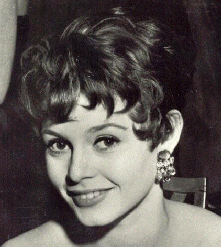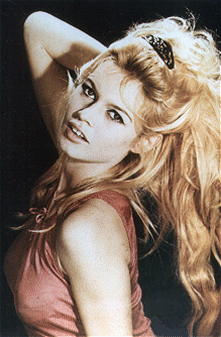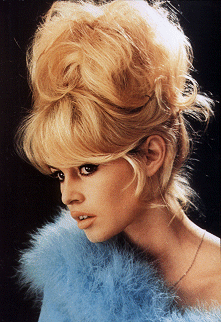Sixties
City presents
a wide-ranging series of
articles on all aspects of the Sixties, penned by the creator of the iconic
60s music paper Mersey
Beat
|
Sixties
City presents
a wide-ranging series of
articles on all aspects of the Sixties, penned by the creator of the iconic
60s music paper Mersey
Beat
|
||||||
|
| Brigitte
Bardot’s appearance on the front cover of 'Elle' magazine in France on 2nd
May 1949, when she was only 14, was what provided her with the opportunity
to discover a career in films. French film director Marc Allegret spotted
the cover and considered she had potential. He instructed his assistant
Roger Vadim to write to her parents requesting a screen test. Her parents
weren’t exactly overjoyed and would have refused, but her grandfather told
them, “Going into films will not make her a lost child.” Vadim arranged
a screen test for a projected film called ‘The Laurels Are Cut.’ The test
wasn’t a success and the film wasn’t made. Vadim, however, was convinced
of her star quality. “Two things struck me about her. First, her style.
She had a way to be very free with her body. And her mind. When I say free
with her body, I’m talking about the way she will walk, move, look at people,
sit. “She was also, for a little bourgeoisie, in a certain way very revolutionary.
She will approach life, any kind of problem, with a really free mind.” They became engaged and Vadim got to work on her career, sending her to Rene Simon’s drama school, which led to her finding roles in her first two films. They were married and Vadim continued shaping BB’s career, determined to make her an international star. The major breakthrough came when Vadim directed her in ‘Et Dieu Crea La Femme,’ which caused a sensation at the time and established her name. Despite the fact that they later divorced, Vadim directed her in several further films, none of which made as much impact as the first. Her films were rather run-of-the-mill movies and she spurned the attentions of Hollywood, preferring to remain and work in her native France.Arguably, apart from ‘And God Created Woman’, her most outstanding films were ‘La Verite’, ‘En Cas De Malheur’, based on a Simenon story and co-starring Jean Gabin and ‘Viva Maria.’ She generally expressed dissatisfaction with her film career, threatening to abandon it on several occasions. She finally did in 1973 after completing ‘The Gay And Joyous Story of Colinot, the Skirt Puller-Upper.’ |
 |
 |
The
World Of Bardot
She was born 28th December 1934 in her parent’s apartment on the fifth floor of 35 Avenue la Bourdonnais, Paris. Her family all used pet nicknames. Brigitte was Bricheton or Bri-Bri, her sister Marie-Jeanne was Mijanou, her father Louis was Pilou and her mother Ann-Marie was Toty. She is a Libra, was born on a Friday and weighed 7lb 6oz. Brigitte was named after a doll her mother had when she was a child. She attended a private school for your ladies, Hattemer, until she was 16. Her French and Latin teacher Pierre-Marie Querveelle said she was “a terrible student, bottom of the class,” and added, “She won’t go anywhere.” As a child she wore wire-rimmed spectacles. She studied dancing at the Conservatoire Nationale de Danse – another pupil was Leslie Caron. At the age of 14 she appeared on the cover of Elle magazine on 2nd May 1949 – her mother requested that her name not be used and they presented the initials BB for the first time. Film director Marc Allegret noticed Brigitte on the Elle cover and sent his assistant Roger Vadim in search of her. At the age of 15 she tried to commit suicide – her mother had a presentiment and returned home early one night to find her daughter unconscious with her head in a gas oven. She was married to Roger Vadim on 20th December 1952, first at the Town Hall in the 17th district of Paris and then at the Church of Notre Dame de Grace in Passy. |
|
Brigitte was paid the equivalent of £220 for her film
debut in ‘The Norman Hole.’ The playwright Jean Anoulh wrote an original
screenplay for her called ‘The Ginger Cat’, but it was never made. When
she arrived in Britain to film ‘Doctor at Sea’ she said, “I’ve brought several
nightdresses because I hope someone will invite me out.” ‘And God Created Woman’, was filmed at a small fishing village, St. Tropez, and during the filming she began her affair with co-star Jean-Louis Trintignant. She called him Jean-Lou and he was married to, although separated from, Stephane Audran. The affair lasted six months. ‘And God Created Woman’ was initially a flop in France, but a smash hit internationally. Roger Vadim began to live with Annette Stroyberg and they had a baby daughter the day after Bardot and Vadim were divorced. There were scores of offers to appear in Hollywood films – but she refused. She had an affair with guitarist Sacha Distel and said, “He brought music into my life.” In 1959 she married Jacques Charrier, her co-star in ‘Babette Goes to War.’ On 11th January 1960 she gave birth to a 7lb 4oz boy Nicolas Jacques Charrier. The day after her 26th birthday she swallowed an entire jar of sleeping pills and cut her wrists – she would have died but a 13 year old girl found her lying in the garden. When she was divorced in 1962 she allowed her husband to have custody of their son. In 1966 she married millionaire Gunter Sachs. They were divorced in September 1969. Brigitte decided to retire after making her 48th film ‘The Gay And Joyous Story of Colinot, the Skirt Puller-Upper’ in 1973. |
 |
|
The Films Of Bardot THE NORMAN HOLE (Le Trou Norman) 1952 Brigitte was to comment: “My first film – it was terrible…everyone was kind enough to me, helping me over many difficulties and making what I did not like more agreeable. As time went on I felt I was acting more and more badly – fantastically badly! Film-making wasn’t at all what I had expected. I felt let down. Was it always to be like this? So mechanical, so insipid, so exhausting. I had my dream shattered.” The film concerns the events which ensue when a village idiot inherits the local tavern. THE LIGHTHOUSE KEEPER’S DAUGHTER (Manina, La Fille Sans Voile) 1952 Commented Brigitte: “I took the part of a wild little girl unclothed and as lacking in experience as the one in the first film. My acting seemed even worse – later I used to blush with shame at what I used to call my setbacks. I had made a bad start – a cheap little starlet hardly acting at all in a very mediocre film.” Brigitte starred as Manina, a lighthouse keeper’s daughter who saves the life of a young student who had been double-crossed by a smuggler in his search for a treasure trove. THE LONG TEETH (Les Dents Longues) 1952 Brigitte appeared in only one walk-on scene in this film, appearing with her real life husband Roger Vadim as witnesses to a screen marriage. THE IMAGE OF HIS FATHER (Le Portrait De Son Pere) 1953 When a young farmer inherits a controlling interest in a large department store and moves to the big city, he begins a romance with Domino (Brigitte), but then turns her down and returns to the farm and his former sweetheart. ACT OF LOVE 1953 Brigitte was to say, “I was nervous when I met Kirk Douglas on the set. ‘Take it easy,’ Kirk said to me. ‘You’ll make it. You’ll get up there all right.’” Set in a hotel immediately following the Second World War, Brigitte plays a maid who observes the romance between a G.I. (Douglas) and her friend (Dany Robin).
THE LIGHT ACROSS THE STREET (La Lumiere De’en Face) 1955 The 21-year-old actress portrayed Olivia, young bride of a café owner who, because of a traumatic road accident, can’t consummate the marriage. MAM’ZELL PIGALLE (Cette Sacree Gamine) 1955 BB appears as a precocious young dancer, Brigitte Latour, whose father is on the run from the police, wrongly accused of being a forger. NERO’S WEEKEND (Mio Figlio Nerone) 1956 Another French/Italian co-production in which Brigitte appears as Nero’s mistress Poppea and has a much-publicised scene in which she bathes in asses milk. MAM’ZELLE STRIPTEASE (Le Effeuillant la Marguerite) 1956 As Agnes Dumont, Brigitte flees to Paris and pawns a book she finds in her brother’s house. Too late, she discovers that the house is really the Balzac Museum of which her brother is only the curator. To raise the money to buy back the book she wins an amateur striptease contest. AND GOD CREATED WOMAN (Et Dieu Crea la Femme) 1956 The film that made her an International star, directed by her husband Roger Vadim. The film opens with BB lying sensationally on a beach – in the nude. This was also the film which resulted in the village of St. Tropez, where it was set, becoming a major holiday resort. THE BRIDE IS TOO BEAUTIFUL (La Mariee Est Trop Belle) 1956 The story of a village girl who is turned into a successful Paris model by a couple of magazine editors – she ends up marrying one of them. PARISIENNE (Une Parisienne) 1957 Brigitte, as a daughter of the French Premier, flirts with Prince Charles – not The Royal personage, but the son of a fictitious Queen Greta. HEAVEN FELL THAT NIGHT (Les Bijoutiers Du Clair de Lune) 1957 Another Roger Vadim film. A tragedy set in Spain in which BB co-starred with Stephen Boyd. She portrayed a convent girl who runs off with a murderer and is killed in crossfire when police close in on the couple.
IT HAPPENED AT NIGHT (L’Affaire D’Une Nuit) 1960 Brigitte only appeared in a brief walk-on part and wasn’t even included in the credit listing. PLEASE NOT NOW (La Bride Sue Le Cou) 1960 Roger Vadim directed this slapstick comedy in which Brigitte plays a model pretending to have an affair in order to make her photographer boyfriend jealous. FAMOUS LOVES (Les Amour Celebres) 1960 A series of stories featuring a number of major French stars. In the ‘Agnes Bernauer’ episode BB appears opposite Alain Delon in the tragic story of a village girl who is secretly married to a prince. When the secret is revealed, he is disinherited. PRIVATE LIFE (Vie Privee) 1961 Brigitte co-starred with Marcello Mastroianni in a story of a successful actress who falls to her death. She said, “This is my last film. Maybe one more with Vadim, that’s all. After this, I retire.” WARRIOR’S REST (Le Repos Du Guerrier) 1962 A box office smash in France. As a bourgeoise woman called Genevieve, BB has an affair with a whiskey-drinking thug, but discovers there is a better side to his nature. At the time she said, “This is my last film – I promised Vadim I’d do it.” CONTEMPT (Le Mepris) 1963 Based on a novel by Alberto Moravia, directed by Jean-Luc Godard and co-starring Jack Palance. Brigitte noted, “I’ve joined the New Wave now! Godard was really scared, you know. Me, too. He came to see me. We call each other Monsieur Godard and Mademoiselle Bardot. He watched me serve tea – he said he had to get to know me as I really am. Later, he wouldn’t say anything at all.” PAPARAZZI 1963 A documentary about the notorious Italian news photographers. There are scenes in which the paparazzi pursue Bardot during the filming of ‘Le Mepris.’ TENTAZIONI PROIBITE 1963 Another documentary, made at the same time as ‘Paparazzi’, by the same director Oswaldo Civirani, this time focussing on Brigitte’s private life. A RAVISHING IDIOT (Une Ravissante Idiote) 1963 A spy romp. Brigitte came to film some scenes in London, but the crowds which followed her were so large that the London locations had to be specially built back in France. MARIE SOLEIL 1964 Another film in which Bardot appears in a brief walk-on part. DEAR BRIGITTE 1964 Only a cameo role in this American film starring James Stewart. An eight year old boy is a child prodigy, a mathematical genius – and he has a crush on Brigitte. VIVA MARIA 1965 Two actresses become involved in a South American revolution at the turn of the century and invent striptease. Arguably, Bardot’s best film, directed by Louis Malle, in which she co-starred with Jeanne Moreau. She remarked: “I’m not worried about the billing. Nor is Jeanne Moreau. The whole thing delights me. I like Jeanne very much. Perhaps you could say we are two aspects of the ideal woman. I hardly knew her until the film was proposed, then we dined together, listened to songs together and hit it off immediately.” MASCULIN-FEMININ 1965 Another Jean-Luc Godard film. Brigitte only appears in a single scene, as an actress during a rehearsal. TWO WEEKS IN SEPTEMBER (A Coeur Joie) 1966 Brigitte portrays Cecile, a Parisian model who arrives in Swinging London and is romantically involved with two men, one a photographer, the other a geologist. HISTOIRES EXTRAORDINAIRES (Tales of Mystery) 1967 Once again Brigitte starred opposite Alain Delon in a film of several short stories. This was the Edgar Allen Poe tale, ‘William Wilson’, and a raven-haired BB was a mysterious woman who is really the conscience of a gambling Army officer.
DON JUAN – or –IF DON JUAN WERE A WOMAN (Don Juan 1973 – ou - Et Si Don Juan Etair Une Femme) 1973 Directed by Roger Vadim, who said, “The Don Juan of our day is the woman – Brigitte Bardot in real life.” The film showed the much publicised nude scenes between BB and Jane Birkin. THE GAY AND JOYOUS STORY OF COLINOT, THE SKIRT PULLER-UPPER (L’Histoire Tres Bonne Et Tres Joyeuse De Colinot Trousse-Chemise) 1973 Costume drama set in 15h Century France. |
| Bardot
And Birkin With their controversial nude lesbian scene In 1973, 16 years after she made her sensational appearance in ‘And God Created Woman’, a 38-year-old Brigitte Bardot once again hit the headlines with her penultimate film ‘If Don Juan Were a Woman.’ It was the first time she’d appeared before the cameras in the nude for 15 films and was the first time she’d ever appeared full-frontal in a movie. The controversy, however, centered on a graphic lesbian bedroom scene. Roger Vadim had, for a number of years, been attracted by the idea of casting Bardot in a film featuring a lesbian relationship, but she’d refused all previous requests. Vadim himself had said, “If one woman in the world is not bi-sexual, it is Brigitte. She never could stand that. She is not at all sexually interested in girls.” ‘If Don Juan Were A Woman’ focussed on three affairs of a woman, Joanne. In one of them, Joanne decides to take revenge on a sadistic, vain millionaire, Prevost (Robert Hossein), with whom she is having an affair. She seduces Provost’s timid young wife Clara and arranges for him to find the two of them in bed together. She turns the knife even deeper by refusing his request that he join them! When Vadim had arranged to make another film with his ex-wife, he decided it was time for the legend of the child-woman to be buried and announced, “The Don Juan of our day is a woman. Brigitte Bardot in real life.” He’d worked on the script through the winter of 1971 and early the following year, then called in Jean Cau, Prix-Goncourt-Winning novelist to work on it with him. It was Cau who decided to introduce the lesbian bedroom scene. Commenting on the nude scene, Vadim said, “If there’s homosexuality between men they have to be queer, but women can have relationships with other women without being dykes. Brigitte seduced this girl to get at her man, and the girl is enchanted not to be treated as a sex object for once in her life.” The girl who shared the erotic clinches with Bardot was British actress Jane Birkin who had been the first actress to appear full frontal in nude scenes in a major film when she bared all in the 1966 Antonioni film ‘Blow Up’, set in Swinging London. The girl who’d appeared nude with her in that film was Gillian Hills, another Vadim protégé. Jane had been living with French singer Serge Gainsbourg and had recorded an erotic song with him that had become an international hit, ‘Je T’Aime, Moi Non Plus.’ Brigitte had, in fact, originally recorded this same number with Gainsbourg in 1968, but Gunther Sachs, her husband at the time, refused permission for it to be released. The character of Jeanne is a libertine, who Vadim described as, “A woman who affirms her personality through her conquests, without thinking of the consequences for other people or for herself. For she destroys herself through the game she plays.” In one of the stories she torments a young Spanish guitarist (Robert Walker Jr) into offering his life in exchange for making love to her. After they’ve been to bed together he slashes his wrists. She confesses this ‘murder’ to her cousin Paul (Mathieu Carriere), a priest, and then proceeds to seduce him. Jeanne had earlier destroyed the life of a politician, making him desert his wife and child, causing him to lose his career and turn into a drunkard. Pierre (Maurice Ronet) meets her again and intends for them both to die in a blazing house, but she rescues him, at the cost of her own life. The film wasn’t a great box office success, despite the vast publicity generated by the controversial love scenes and the same year, after completing ‘L’histoire tres bonne et tres joyeuse de Colinot Trousse- Chemise, she retired from the screen. |
 |
|
Article
|